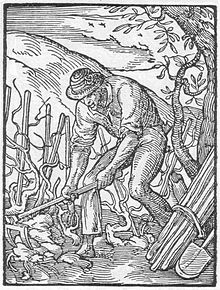Extract from Wikipedia. ........ Types of hoe



Types
There are many types of hoes of quite different appearances and purposes. Some can perform multiple functions. Others are intended for a specific use.
There are two main classes of agricultural hoe: draw hoes for shaping, and scuffle hoes for surface weed control.
A draw hoe has the blade set at approximately a right angle to the handle. The user chops into the ground and then pulls (draws) the blade towards them. Altering the angle of the handle can cause the hoe to dig deeper or more shallowly as the hoe is pulled. A draw hoe can easily be used to cultivate soil to a depth of several inches. A typical design of draw hoe, the "eye hoe", has a ring in the head through which the handle is fitted. This design has been used since Roman times.
A scuffle hoe is used to scrape the surface of the soil, and to loosen the top inch or so, and to cut the roots, remove, and disrupt the growth of weeds efficiently. These are mainly of two different designs: the Dutch hoe and the hoop hoe.

Eye hoe heads, some with sow-tooth (German: Sauzahn), Centro Etnográfico de Soutelo de Montes, Pontevedra,Spain
The term 'hand hoe' most commonly refers to any type of light-weight, short-handled hoe, although it may be used simply to contrast hand-held tools against animal or machine pulled tools.
Draw hoes
- The typical farming and gardening hoe with a heavy, broad blade and a straight edge is known as the grub hoe, grab hoe, pattern hoe, Italian hoe,azada[ or dago hoe ("dago" is an ethnic slur referring to Italians, Spaniards, or Portuguese).
- Ridging hoes also known as warren or drill hoes are triangular (point-down) or heart-shaped draw hoes particularly for creating narrow furrows (drills) and shallow trenches for planting seeds and bulbs.

Hoedad (tree-planting tool) Kaibab National Forest, Arizona, USA
- Hoedads (also, "hoedags") are hoe-like tools used for planting trees.ccording to Hartzell (1987, p. 29), "The hoedag [was] originally called skindvic hoe... Hans Rasmussen, legendary contractor and timber farm owner, is credited with having invented the curved, convex, round-nosed hoedag blade which is widely used today" (emphasis added).
- The mortar hoe, a tool specific to hand mixing mortar and concrete, has the appearance of a typical square-bladed draw hoe with the addition of large holes in the blade.
Scuffle hoes
- The Dutch hoe is a design that is pushed or pulled through the soil to cut weeds just under the surface. A Dutch hoe has a blade "sharp on every side so as to cut either forwards and backwards". The blade must be set in a plane slightly upwardly inclined to the dual axis of the rod used as a handle stick. The user uses the handle to push the blade forward, forcing it below the surface of the ground and maintaining it at a shallow depth in the surface layer of soil by altering the angle of the handle whilst pushing. A push hoe can easily cultivate and remove weeds etc. from the surface layer of the soil.
- The hoop hoe (also known as action, oscillating, hula, stirrup, pendulum weeder, or swivel hoes) have a double-edge blade that bends around to form a rectangle attached to the handle. Weeds are cut just below the soil surface as the blade is pushed & pulled through the area. The back and forth motion is highly effective with cutting weeds in loose or breakable soil. Widths of the blade typically range between three and seven inches. Its tool-head is a loop of flat, sharpened strap metal. It is not as efficient as a draw hoe for moving soil.
- The collinear hoe has a narrow, razor-sharp blade which is used to slice weeds by skimming it just under the surface of the soil with a sweeping motion; it is unsuitable for tasks like soil moving and chopping. It was designed by Eliot Coleman in the late 1980s.
- The Swoe hoe is a modern one-sided cutting hoe - a variant of the Dutch hoe.
Other hoes
Hoes resembling neither draw nor scuffle hoes include:
- Wheel hoes are, as the name suggests, a hoe or pair of hoes attached to one or more wheels. The hoes are frequently interchangeable with other tools.
- Horse hoes, resembling small ploughs, were a favourite implement of agricultural pioneer Jethro Tull, claiming in his book "Horse Hoeing Husbandry" that "the horse-hoe will, in wide intervals, give wheat throughout all the stages of its life, as much nourishment as the discreet hoer pleases". The modern view is that, rather than nutrients being released, the crop simply benefits from the removal of competing plants.The introduction of the horse hoe, together with the better-known seed drill, brought about the great increase farming productivity seen during the British Agricultural Revolution.

Fork-hoe depiction in Der Rebmann (the vine-dresser). Jost Amman, Das Ständebuch, 1568
- Fork hoes, (also known as prong hoes, tined hoes or bent forks) are hoes that have two or more tines at right angles to the shaft. Their use is typically to loosen the soil, prior to planting or sowing.
- Clam hoes, made for clam digging
- Adze hoes, with the basic hoe shape but heavier and stronger and with traditional uses in trail making,
- Pacul or cangkul (hoes similar to adze hoe from Malaysia and Indonesia)
- Gang hoes for powered use (in use at least from 1887 to 1964


No comments:
Post a Comment